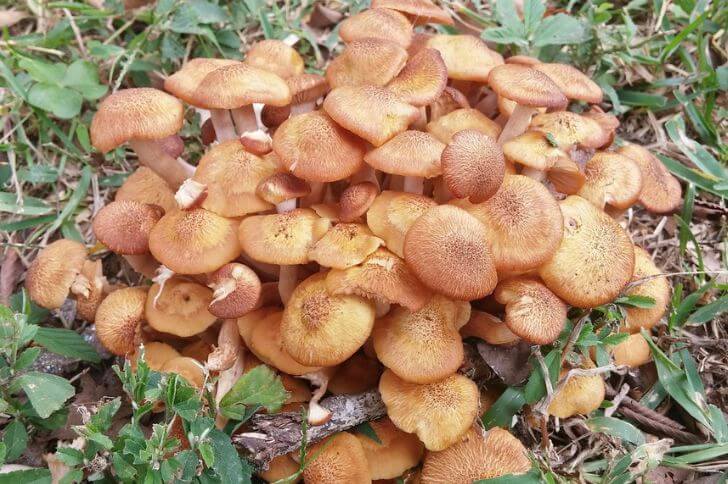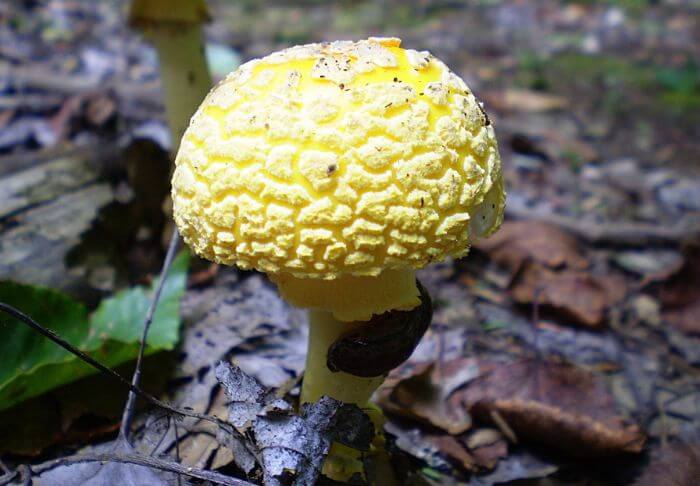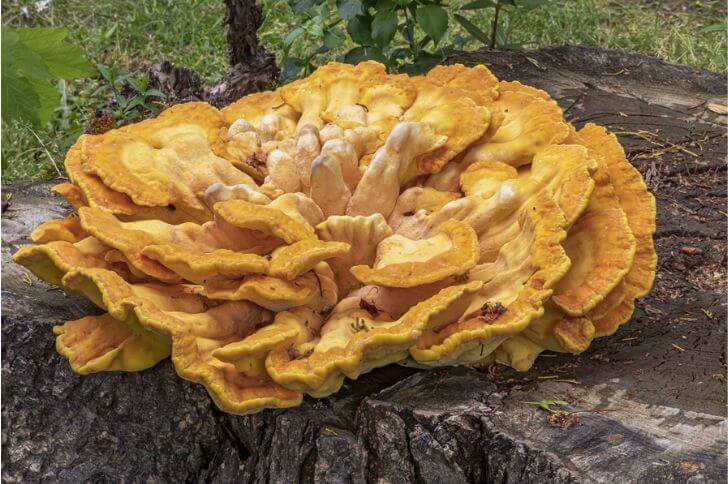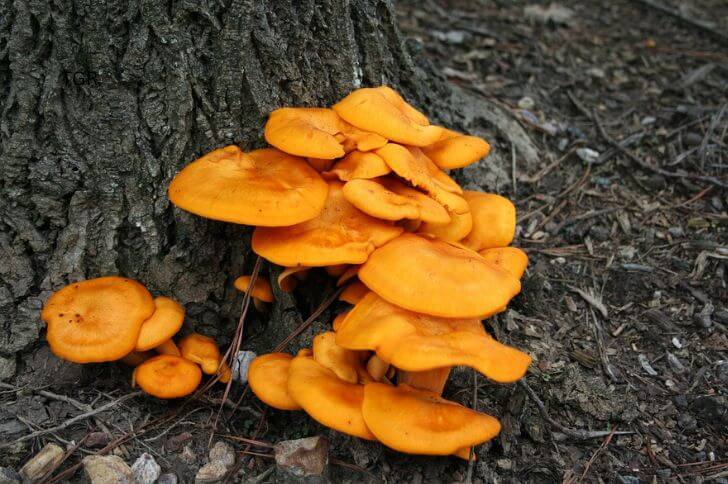The Lone Star State is known for its diverse landscapes, rich cultural heritage, and abundant wildlife.
But hidden within the piney woods and rolling hills of East Texas lies a peculiar natural wonder that has captured the imagination of both scientists and nature enthusiasts alike – the yellow mushrooms of Texas.
These mysterious fungi, with their vibrant golden hues and otherworldly appearance, have become a fascinating subject of study and intrigue in the world of mycology.
List of Yellow Mushrooms in Texas
1. Ringless honey mushrooms

Ringless honey mushrooms (Armillaria tabescens) are a common sight in the woodlands of Texas, characterized by their telltale ringless stalks and honey-colored caps.
Their parasitic nature makes them notorious for their ability to colonize and kill trees, but they also play a vital role in recycling nutrients and organic matter in forest ecosystems.
These mushrooms are often found clustered around tree stumps or at the base of living trees, making them relatively easy to spot for foragers seeking out a tasty addition to their meals.
While some enthusiasts eagerly seek out ringless honey mushrooms for culinary purposes, it’s essential to exercise caution when consuming them.
Despite their appealing appearance, these mushrooms can cause gastric upset in some individuals and should be cooked thoroughly before consumption.
2. Witch’s Butter
Witch’s Butter, Tremella mesenterica, is a fascinating species of jelly fungus found in the woodlands of Texas. Its vibrant yellow-orange color and gelatinous texture make it easily recognizable amidst the forest undergrowth.
One of the most intriguing characteristics of Witch’s Butter is its ability to absorb and retain moisture, allowing it to thrive even in dry conditions. This unique adaptation sets it apart from other fungi commonly found in the area.
While many fungi are toxic or inedible, Witch’s Butter has been traditionally used in culinary practices due to its mild flavor and gelatinous consistency.
It is often added to soups or stews for added texture and nutritional value. When properly identified by an experienced individual, Witch’s Butter can be a delightful addition to wild food enthusiasts’ repertoires.
3. Leucocoprinus Birnbaumii

The Leucocoprinus birnbaumii, colloquial name yellow houseplant mushroom, is a fascinating fungus found in Texas. Its physical characteristics are truly striking, with vibrant yellow caps and slender stems that provide a pop of color in indoor potted plants.
Despite its delicate appearance, this mushroom is surprisingly resilient and can thrive in a variety of conditions, making it an intriguing addition to the local flora.
In Texas, the presence of Leucocoprinus birnbaumii serves as a reminder of the interconnectedness of nature and human spaces. The sight of these bright mushrooms peeking out of planter or mulch can spark curiosity and appreciation for the small wonders that exist alongside our daily lives.
4. Amanita flavoconia
Amanita flavoconia, commonly called orange amanita or yellow patches, is a strikingly beautiful mushroom that can be found in hardwood forests across North America.
Its identification can be tricky, as it features a bright orange-yellow cap with patches that fade to a lighter shade over time. The gills are free and white, while the stem is adorned with a distinctive ring and bulbous base.
Despite its vibrant appearance, Amanita flavoconia should not be harvested for consumption.
Another way you can identify this yellow mushroom in Texas is to pay close attention to its surroundings. This species tends to form mycorrhizal relationships with hemlock, so spotting it in these specific habitats can aid in its accurate identification.
Additionally, taking note of the presence of other indicator species like mosses and lichens can offer further clues about the potential presence of Amanita flavoconia.
Related Read: Check common Texas fungi
5. Gymnopilus Subspectabilis (Laughing Mushroom)
Gymnopilus subspectabilis, also known as the Spectacular Rustgill, is a species of yellow mushroom that can be found in Texas.
One way to identify this captivating fungus is by examining its cap, which ranges from yellow-orange to brown and often features concentric rings or zones of color.
Additionally, the gills of Gymnopilus subspectabilis are adnate or slightly decurrent and can be orange-yellow with a rusty tint when mature.
Another key feature for identifying laughing mushrooms is its spore print, which typically appears rusty brown. This distinct characteristic sets it apart from other similar-looking mushrooms in its genus.
It’s important to note that while Gymnopilus subspectabilis is visually striking, it’s crucial for foragers to have advanced knowledge and experience before attempting to identify and consume any wild mushrooms.
6. Dyer’s polypore
The identification of Dyer’s polypore, also known as Phaeolus schweinitzii, presents a fascinating challenge for mushroom enthusiasts.
This distinctive fungus features a striking yellow to orange-brown cap with a velvety texture, making it easily recognizable in the wild.
While its appearance may seem unique among polypores, its identification can be further confirmed by observing its growth on stumps and examining its undersurface, which is covered in small pores through which spores are released.
One intriguing aspect of Dyer’s polypore identification lies in the potential for confusion with similar species such as Sulfur Shelf or Chicken of the Woods mushrooms.
The nuances in coloration and growth patterns provide an exciting opportunity for keen observers to delve deeper into the world of fungal diversity.
7. Hypholoma fasciculare (Sulphur Tuft)
Hypholoma fasciculare, commonly known as the sulfur tuft or clustered woodlover, is a fascinating and distinctive mushroom species that can be found in various types of woodlands around the world.
One of its most prominent characteristics is its sulphur yellow coloration, which makes it stand out amongst other mushrooms. When identifying this yellow mushroom in Texas, it’s important to look for densely clustered caps that are convex when young and become flattened with age. The gills also play a crucial role in identification, typically being greenish-yellow when the mushroom is fresh and turning dark brown as it matures.
Where can you find sulphur tuft mushrooms? I typically spot them in spring and autumn. Check on dead conifers. It’s important to note, these yellow mushrooms of Texas are inedible.
8. Orange-jelly spot
Orange jelly spot identification can be a tricky task, as it requires keen observation and a thorough understanding of the characteristics of this particular fungus.
One distinctive feature to look for is the bright orange-yellow coloration, which usually appears in small circular or irregular-shaped spots on various surfaces.
These spots can sometimes merge to form larger patches with a gelatinous texture, hence the name orange jelly spot.
Another key aspect to consider during orange jelly spot identification is its preferred habitat. This fungus thrives on dead conifers.
9. Chicken of the woods

The vibrant and flavorful Chicken of the Woods mushroom has been spotted across the woodlands of Texas. With its striking orange and yellow hues, this wild fungi is a sight to behold in the rich forest landscapes of East Texas.
Unlike other mushrooms, Chicken of the Woods doesn’t have traditional gills but instead grows in overlapping shelves.
In addition to its visual appeal, this delectable fungus offers a meaty texture and subtle umami flavor that has captivated foragers and chefs alike.
From sautéing with garlic and butter to adding depth to vegetarian dishes, the versatility of Chicken of the Woods makes it a sought-after ingredient for culinary experimentation.
However, it’s important for eager mushroom hunters to exercise caution as there are various sulphur shelf mushrooms look-alikes. Regardless, when properly identified and harvested, encountering this vibrant woodland treasure is a testament to the natural abundance waiting to be discovered in the heart of Texas.
10. Jack-o’-lantern

Jack-o’-lantern mushrooms, scientifically known as Omphalotus olearius, are captivating and mysterious fungi that can be found in forests and woodlands around the world.
Identifying these mushrooms requires a keen eye and attention to detail. While they may bear a resemblance to some edible species, the gills of Jack-o’-lantern mushrooms glow in the dark when crushed or bruised, making them easily distinguishable from their look-alikes.
Additionally, their tendency to grow in clusters on decaying wood or at the base of trees can aid in identification. It is crucial for foragers and mushroom enthusiasts to familiarize themselves with the distinguishing characteristics of these fungi to avoid accidental ingestion.
11. Pleurotus Citrinopileatus (Golden Oyster)
Pleurotus citrinopileatus, also known as the golden oyster mushroom, is a unique and visually striking species that can be found in both natural forests and cultivated environments.
One of the key distinguishing features of this species is its vibrant yellow to golden color, which sets it apart from other oyster mushroom varieties.
Additionally, its fan or spatula-shaped caps and decurrent gills further aid in identification. It’s important to note that the appearance of Pleurotus citrinopileatus may vary depending on environmental conditions, substrate type, and age of the specimen.
Furthermore, careful attention should be paid to the overall size and shape of the mushrooms, as well as any distinctive markings or textures on their surface.
When examining Pleurotus citrinopileatus specimens for identification, it’s beneficial to consider their habitat and growing conditions. For instance, these mushrooms are often found growing in clusters on hardwood logs or stumps, especially during cooler months.
This distinct preference for certain substrates can be a valuable clue when attempting to positively identify Pleurotus citrinopileatus in the wild or in cultivation.
Final Thoughts:
The presence of yellow mushrooms in Texas is a fascinating and important aspect of the state’s ecosystem.
These unique fungi play a crucial role in decomposition, nutrient cycling, and soil health. As researchers continue to study these mushrooms, it is essential for land managers and policymakers to consider their conservation and protection.
Understanding the ecological significance of yellow mushrooms can lead to better management practices and preservation efforts. It is imperative for us to appreciate and safeguard these natural wonders for future generations to enjoy and study.
Let us work together to ensure the continued existence of these remarkable organisms in the Texas landscape.
source:

